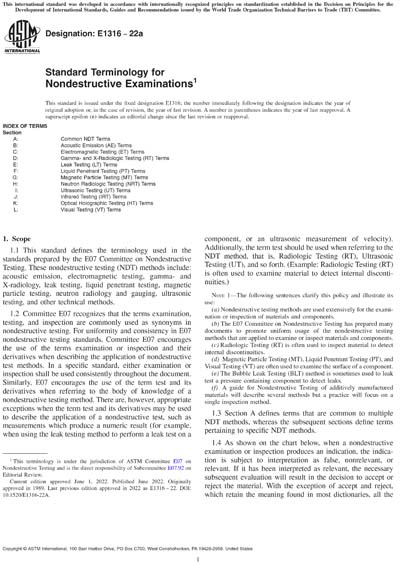Historical
ASTM E1316-22a
Standard Terminology for Nondestructive Examinations
1.1This standard defines the terminology used in the standards prepared by the E07 Committee on Nondestructive Testing. These nondestructive testing (NDT) methods include: acoustic emission, electromagnetic testing, gamma- and X-radiology, leak testing, liquid penetrant testing, magnetic particle testing, neutron radiology and gauging, ultrasonic testing, and other technical methods.
1.2Committee E07 recognizes that the terms examination, testing, and inspection are commonly used as synonyms in nondestructive testing. For uniformity and consistency in E07 nondestructive testing standards, Committee E07 encourages the use of the terms examination or inspection and their derivatives when describing the application of nondestructive test methods. In a specific standard, either examination or inspection shall be used consistently throughout the document. Similarly, E07 encourages the use of the term test and its derivatives when referring to the body of knowledge of a nondestructive testing method. There are, however, appropriate exceptions when the term test and its derivatives may be used to describe the application of a nondestructive test, such as measurements which produce a numeric result (for example, when using the leak testing method to perform a leak test on a component, or an ultrasonic measurement of velocity). Additionally, the term test should be used when referring to the NDT method, that is, Radiologic Testing (RT), Ultrasonic Testing (UT), and so forth. (Example: Radiologic Testing (RT) is often used to examine material to detect internal discontinuities.)
Note 1:The following sentences clarify this policy and illustrate its use:
(a)Nondestructive testing methods are used extensively for the examination or inspection of materials and components.
(b)The E07 Committee on Nondestructive Testing has prepared many documents to promote uniform usage of the nondestructive testing methods that are applied to examine or inspect materials and components.
(c)Radiologic Testing (RT) is often used to inspect material to detect internal discontinuities.
(d) Magnetic Particle Testing (MT), Liquid Penetrant Testing (PT), and Visual Testing (VT) are often used to examine the surface of a component.
(e)The Bubble Leak Testing (BLT) method is sometimes used to leak test a pressure containing component to detect leaks.
(f) A guide for Nondestructive Testing of additively manufactured materials will describe several methods but a practice will focus on a single inspection method.
1.3Section A defines terms that are common to multiple NDT methods, whereas the subsequent sections define terms pertaining to specific NDT methods.
1.4As shown on the chart below, when a nondestructive examination or inspection produces an indication, the indication is subject to interpretation as false, nonrelevant, or relevant. If it has been interpreted as relevant, the necessary subsequent evaluation will result in the decision to accept or reject the material. With the exception of accept and reject, which retain the meaning found in most dictionaries, all the words used in the chart are defined in Section A.
1.5This international standard was developed in accordance with internationally recognized principles on standardization established in the Decision on Principles for the Development of International Standards, Guides and Recommendations issued by the World Trade Organization Technical Barriers to Trade (TBT) Committee.
Content Provider
ASTM International [astm]






